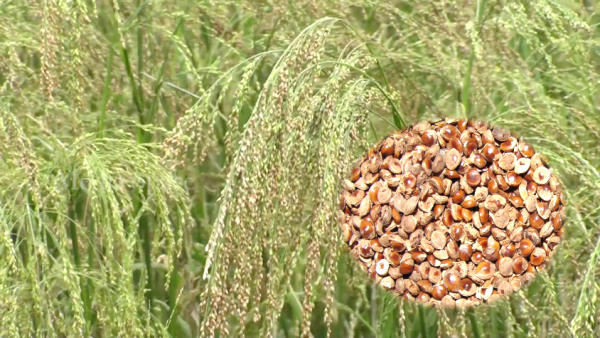
February 20, 2023

Author: HealthyLife | Posted on: February 20, 2023




Kuldhas are clay cups also known as desi cups used for drinking both hot and cold drinks like tea, coffee, lassi or can be used for ice cream. It can be recycled, reused or if thrown it will mix with earth. Now, instead of clay cup, Indian farmers used edible millet to make these kulhads. After drinking instead of throwing the cups one can eat the cup just like a snack.
Why millet? Millets are recognized for their low glycemic index and for providing all good health benefits. Year 2023 is declared as International year of millets by UN following India’s proposal. Millets are environmentally friendly and are affordable. Eating millet khudlha is a great initiative to promote healthy millets eating – Healthy Life
There are millions who enjoy eating ice creams from cones and then munching on the cones too. A Deoria-based farmers’ group in Uttar Pradesh has now come up with ‘kulhads’ made from millet that can be used to drink tea and then eaten as a healthy snack.
Interestingly, these ‘kulhads’ come at a time when 2023 has been declared as the “International Year of Millets” by the United Nations after a proposal from India in 2019.
Christened ‘Chai Piyo aur Kulhad Khao’, these nutritious kulhads, made of co-arse grain of ragi and maize flour, have caught the attention of tea lovers at the ongoing Magh Mela in Prayagraj.
Ankit Rai, a member of the group, said the demand for these ‘kulhads’ has been increasing manifold in rural as well as urban areas of eastern Uttar Pradesh.
He said, “To promote the benefits of millets, we created edible kulhads made of millets about two years ago. We have a special mould wherein we can make 24 cups in one go.”
“Initially, we connected with tea vendors in small villages of east UP, including Deoria, Gorakhpur, Siddharth Nagar and Kushinagar, but we managed to win hearts in other parts as well. Now, the demand has spread to Prayagraj, Varanasi, Lucknow and other districts.”
Talking about the price of these ‘kulhads’, he said, “It takes Rs 5 to shape such kulhads and when tea is served in it, it costs Rs 10. The ‘kulhads’ are also eco-friendly. They are in line with Prime Minister Narendra Modi’s Swachh Bharat Mission as there is zero wastage.”
Women are mostly involved in making ‘kulhads’ of millet for health benefits.
Syndicated article from IANS

Marichyasana is one legged seating pose where yogi will sit on floor by extending one leg and with spinal twist. It is an intermediate level yoga pose. Pose dedicated to great sage Marichi who is one of the seven sages (saptarishis). Marichi means “ray of light”. Sage Marichi is the founder and originator of Hindu Vedanta. Apart from calming the mind, pose helps to tone the body and activates digestive system – Healthy Life
LEVEL: Beginner
Anatomy: Digestive System, Shoulders, Spine
Pose Type :Forward Bend, Hip Opener, Seated
Sanskrit :Marichyasana (mar-ee-chee-AHS-anna) Marichi = a sage; son of the creator Brahma
BENEFITS :
CONTRAINDICATIONS:
HOW TO:
MODIFY OR REPLACE:
Alternatives:
Modifications:
SEQUENCING TIPS:
Before:
After:
TEACHING CUES:
VARIATIONS:
WATCH OUT FOR:
Article and image published here with prior permission from beyogi.com

Little Millet (Panicum miliare) commonly known as Gundali or Goudli is one among the minor millets grown to a limited extent all over India up to altitudes of 2100 m. This crop can be well adopted to different types of soil. Storage of the seeds is easy and grains have excellent storage properties in any conditions. It is a relative of proso millet, but the seeds of little millet are much smaller than proso millet. It is one of the important crops that has been around more than 5000 years and is good source of food, fodder and nutritional securities at both farm and regions.
Because of low carbohydrate content, slow digestibility, and low water-soluble gum content little millet has multiple health benefits. The complex carbohydrates, phenolic compounds, antioxidant content present in them helps to prevent metabolic disorders like diabetes, cancer, obesity etc.
Image credit: Mediaspace plus &

Proso millet (Panicum miliaceum L.) is an underutilized crop which is highly nutritious cereal grain used for human consumption, bird seed, and/or ethanol production. Grains of proso millet are a rich source of vitamins (niacin, B-complex vitamins, folic acid), minerals (P, Ca, Zn, Fe) and essential amino acids (methionine and cysteine), starch, and phenolic compounds like antioxidants and betaglucans.
Seeds also contain components with healing benefits, which decrease the level of low-density lipoprotein cholesterol in blood and injury to the liver and high lecithin content which supports the neural health system.
Image credit: Jschnable, CC BY 4.0 <https://creativecommons.org/licenses/by/4.0>, via Wikimedia Commons

In India, Kodo millet (Paspalum scrobiculatum) grown mostly in the Deccan region and the cultivation extends to the foothills of Himalayas. Kodo millet is rich in dietary fiber and minerals like iron, antioxidant.
The phosphorus content in kodo millet is lower than any other millet and its antioxidant potential is much higher than any other millet and major cereals, higher amount of antioxidants helps against oxidative stress and maintain glucose concentrations in type 2 diabetes Kodo millet is useful in curing asthma, migraine, blood pressure, heart attack and atherosclerosis, diabetic heart disease and for postmenopausal in women.
Image credit: Indiamart.com, Eat India right